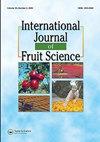Optimizing Nitrogen, Phosphorus, and Potassium Fertilization Rates for Fruit Performance of Chinese Cherry (Prunus pseudocerasus Lindl.)
IF 2.4
3区 农林科学
Q2 HORTICULTURE
引用次数: 4
Abstract
ABSTRACT Attempts had been made to optimize nitrogen (N), phosphorus (P) and potassium (K) fertilization rates for increased fruit performance of Chinese cherry (Prunus pseudocerasus Lindl.). This study was conducted using a randomized block design (RBD) consisting of three factors and four levels, totaling to 14 treatments with each treatment repeated in triplicate. The results illustrated that the fertilization application increased the trunk, leaf, crown and new shoot growth, however, the optimal combination of N, P, and K (NPK) fertilization for growth varied among different parts of the young tree. Moreover, the fruit weight and size, internal quality, and fruit set rate (FSR) were positively affected by fertilization. Specifically, the no. 12 treatment (0.3 kg N + 0.4 kg P + 0.2 kg K) contained the optimal NPK combination for enhanced fruit size and cherry fruit set. Similarly, although the treatment is not the maximum of NPK concentration, the no. 12 treatment for mean daily values of Pn (MDVP) and the NPK concentration in leaf was significantly higher compared to other treatments. Additionally, Pearson’s correlation analysis suggests that the FSR was positively and significantly correlated with fruit weight (FW), fruit vertical diameter (FVD) and the soluble sugars (SS) in fruit. In general, the no. 12 treatment was the optimal NPK fertilization rates for young tree growth, fruit quality of Chinese cherry (Prunus pseudocerasus Lindl.) in the Karst region of southwest China.氮、磷、钾对中国樱桃果实性能的优化
摘要为提高中国樱桃果实性能,尝试优化氮磷钾施肥量。本研究采用三因素四水平随机区组设计(RBD),共14个治疗,每个治疗重复3次。结果表明,施氮促进了幼树干、叶、冠和新枝的生长,但氮磷钾(NPK)对幼树生长的最佳施肥组合因幼树不同部位而异。此外,施肥对果实重、大小、内在品质和坐果率均有显著的正向影响。具体来说,是no。12个处理(0.3 kg N + 0.4 kg P + 0.2 kg K)具有提高果实大小和坐果的最佳氮磷钾组合。同样,虽然处理不是氮磷钾浓度的最大值,但处理的氮磷钾含量也不高。12处理叶片日均Pn (MDVP)值和NPK浓度显著高于其他处理。此外,Pearson相关分析还表明,FSR与果实重(FW)、果实纵径(FVD)和果实可溶性糖(SS)呈显著正相关。一般来说,没有。12处理是西南喀斯特地区中国樱桃幼树生长和果实品质的最佳氮磷钾施肥量。
本文章由计算机程序翻译,如有差异,请以英文原文为准。
求助全文
约1分钟内获得全文
求助全文
来源期刊

International Journal of Fruit Science
Agricultural and Biological Sciences-Agronomy and Crop Science
CiteScore
6.40
自引率
0.00%
发文量
64
审稿时长
10 weeks
期刊介绍:
The International Journal of Fruit Science disseminates results of current research that are immediately applicable to the grower, extension agent, and educator in a useful, legitimate, and scientific format. The focus of the journal is on new technologies and innovative approaches to the management and marketing of all types of fruits. It provides practical and fundamental information necessary for the superior growth and quality of fruit crops.
This journal examines fruit growing from a wide range of aspects, including:
-genetics and breeding
-pruning and training
-entomology, plant pathology, and weed science
-physiology and cultural practices
-marketing and economics
-fruit production, harvesting, and postharvest
 求助内容:
求助内容: 应助结果提醒方式:
应助结果提醒方式:


